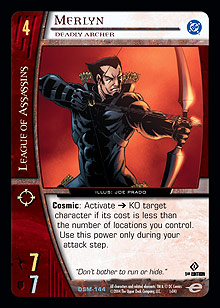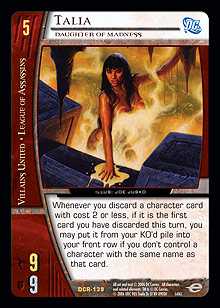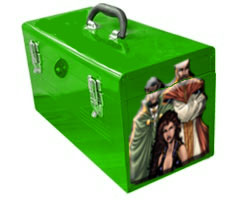
 This week’s Deck Clinic follows on from the sentiments expressed at the end of last week—don’t forget your old decks. I decided to take my own advice and look back at a deck that I considered a “pet” deck for a long time but haven’t touched now for nearly as long. I was reminded of it by a deck along the same lines in a submission from Tombster212 on VSRealms.com. The deck? Brotherhood of Assassins. And given last week’s parting words, I’m going to switch things up a little this week. I’m going to give you my old list. Think of it as any other submission. It’s out of date, it could probably have used a little work at the time, and the newest card in the deck is Merlyn, Deadly Archer. Seven expansion sets and three starter sets have been released since this list took me to 22nd place at $10K London back in March of last year. That’s a lot of new cards and completely different competition to take into account. Well, some of it is different; the Titans, of course, never go anywhere.
This week’s Deck Clinic follows on from the sentiments expressed at the end of last week—don’t forget your old decks. I decided to take my own advice and look back at a deck that I considered a “pet” deck for a long time but haven’t touched now for nearly as long. I was reminded of it by a deck along the same lines in a submission from Tombster212 on VSRealms.com. The deck? Brotherhood of Assassins. And given last week’s parting words, I’m going to switch things up a little this week. I’m going to give you my old list. Think of it as any other submission. It’s out of date, it could probably have used a little work at the time, and the newest card in the deck is Merlyn, Deadly Archer. Seven expansion sets and three starter sets have been released since this list took me to 22nd place at $10K London back in March of last year. That’s a lot of new cards and completely different competition to take into account. Well, some of it is different; the Titans, of course, never go anywhere.
Brotherhood of Assassins
Tom Reeve
Characters
4 Talia, Daughter of the Demon’s Head
4 Quicksilver, Pietro Maximoff
4 Mystique, Raven Darkholme
4 Merlyn, Deadly Archer
1 Ra’s al Ghul, Immortal Villain
3 Magneto, Eric Lehnsherr
3 Quicksilver, Speed Demon
1 Scarlet Witch, Wanda Maximoff
4 Mystique, Shape-Changing Assassin
3 Magneto, Master of Magnetism
1 Ra’s al Ghul, The Demon’s Head
Plot Twists
4 The Demon’s Head
3 Insignificant Threat
3 Tower of Babel
Locations
4 Lost City
4 Metropolis
4 Mountain Stronghold
3 Avalon Space Station
1 Flying Fortress
1 Latverian Embassy
Takes you back, doesn’t it? Simpler, slower times. Instead of the off-curve craziness of High Voltage, you had to break down the purple armada that were the Curve Sentinels. Common Enemy, The New Brotherhood, Teen Titans, and even FF Toys were seen in numbers. The Marvel Knights expansion had just hit the scene, and already people were experimenting with Midnight Sons-fueled Fearsome Five monstrosities curving out to a boosted Dr. Light, Arthur Light. His notorious 3-drop version, of course, was still a few months away.
Now, this wouldn’t be much of an article if all I did was give you an old list and wait for the emails to flood in. Instead, I’m going to go on a brief tour of the seven new batches of cards from Marvel Knights to Heralds of Galactus, taking a brief detour to pick up anything interesting from the three starter decks (Batman, Fantastic Four, The X-Men). With one Marvel team and one DC team, we’re going to have to keep our eyes open. Remember, we’re not just looking for Brotherhood and League of Assassins cards, but also generic or semi-team-stamped resources that might bring something useful to the deck.
Digging Through the Crates
Marvel Knights
The Marvel Knights expansion offers us little, partly due to the heavily team-stamped nature of many of the most powerful cards. The Dagger, Child of Light/Midnight Sons engine seems unnecessary for a deck that’s only running characters of two teams and already has search cards that can find team-ups. The omnipresent Mikado and Mosha, Angels of Destruction is worth noting on our drive-by before we get to the Brotherhood legacy cards in the set, Monument to a Madman and Scarlet Witch, Eldritch Enchantress. From the generic cards, Psychoville provides a way to drag characters out of the hidden area for a beating, while Meltdown is flexible equipment removal. If we decide we have issues with opposing equipment, though, we already have access to Misappropriation from the Web of Spider-Man set.
Green Lantern Corps
The Green Lantern Corps expansion has similar issues to Marvel Knights when it comes to the majority of the cards, but they aren’t just team-stamped, they’re willpower-stamped too. There are, however, three legacy cards for the League of Assassins team: Sensei, Martial Arts Master; Dr. Ebenezer Darrk, Original Leader of the League; and Shadows of the Past, the pseudo-Tower of Babel. There are a pair of generic locations of potential interest: Coast City and Birthing Chamber.
The Avengers
 Moving on to The Avengers, none of the main teams have any real affinity for locations or powering-up, or have any particularly interesting characters to bring to the table for a deck like BoA. Hawkeye, Clinton Barton is probably the sole exception, providing a source of direct, out-of-combat stuns if we end up running some kind of toolbox. Moving on to legacy and generic cards, Mammomax, Elephant Boy is the only Brotherhood character. He has impressive stats, but sadly his utility is greatly diminished in a full-curve deck; he will only get to attack once, either on turn 3 or 4 (depending on who controls the initiative). System Failure and Avengers Disassembled are worth pointing out, but are probably too narrow to justify inclusion.
Moving on to The Avengers, none of the main teams have any real affinity for locations or powering-up, or have any particularly interesting characters to bring to the table for a deck like BoA. Hawkeye, Clinton Barton is probably the sole exception, providing a source of direct, out-of-combat stuns if we end up running some kind of toolbox. Moving on to legacy and generic cards, Mammomax, Elephant Boy is the only Brotherhood character. He has impressive stats, but sadly his utility is greatly diminished in a full-curve deck; he will only get to attack once, either on turn 3 or 4 (depending on who controls the initiative). System Failure and Avengers Disassembled are worth pointing out, but are probably too narrow to justify inclusion.
Justice League of America
It’s with Justice League of America that we really start picking up options. The only legacy card for the League of Assassins is Poisoned!, and with the plague counter not of use, the -1 DEF is too small to be worth serious consideration. Among the equipment in the set, however, lies one standout card that makes up for the lack of legacy content—Nth Metal. The power of this card in decks based around Lost City and Avalon Space Station is well known; as recently as April this year, Angel Luna took an Nth Metal-powered Big Brotherhood deck to the semifinals of $10K Minneapolis. Justice League of America also introduces the ally mechanic, which, although incompatible with Lost City itself, meant that “power-up” effects started to become more common, from Nth Metal itself to cards like Magnificent Seven and Zatanna, Zatanna Zatara. The search card Straight to the Grave has also proven its worth in decks with access to Avalon Space Station. For location search, Justice League of America gives us two alternate 2-drops, Kelex, Faithful Servant and Poison Ivy, Deadly Rose. They’re off-team, and we may not be able to search them out for turn 2, but they’re worth mentioning.
The X-Men
First, we need to point out the elephant in the room—Enemy of My Enemy. Updating a two-team deck without even considering Enemy would be foolish. But more than that, The X-Men saw the Brotherhood themselves brought back for another starring role, with a full 28 characters and attendant plot twists, locations, and equipment. This is where you should focus a lot of your attention; at which points in the curve does an updated BoA list want to recruit Brotherhood characters, and what new options at those drops does The X-Men provide? In addition, semi-team-stamped locations like The Alley and Sewer System provide more options for a possible location toolbox.
Infinite Crisis
 Infinite Crisis is, as can be expected, light on true League of Assassins legacy content, but the inclusion of Talia in the Villains United team affiliation gives us two highly playable characters in her guises as Talia, Beloved Betrayer and Talia, Daughter of Madness. Do these do enough to oust incumbents like Magneto, Eric Lehnsherr and Talia, Daughter of the Demon’s Head? Also, don’t forget Seiobo’s Garden, the League of Assassins location in the set. Looking at the main teams of the set, the Checkmate affiliation has the most in common with the League, as highlighted in the Silver Age deck Deep Green. Does a third team make sense, or are there single cards we can swipe to strengthen our deck without actually adopting the Checkmate affiliation wholesale? Similarly, can we make use of the dual affiliation on the new versions of Talia to dip our toes in the Villains United pool, perhaps for the powerful location The Science Spire?
Infinite Crisis is, as can be expected, light on true League of Assassins legacy content, but the inclusion of Talia in the Villains United team affiliation gives us two highly playable characters in her guises as Talia, Beloved Betrayer and Talia, Daughter of Madness. Do these do enough to oust incumbents like Magneto, Eric Lehnsherr and Talia, Daughter of the Demon’s Head? Also, don’t forget Seiobo’s Garden, the League of Assassins location in the set. Looking at the main teams of the set, the Checkmate affiliation has the most in common with the League, as highlighted in the Silver Age deck Deep Green. Does a third team make sense, or are there single cards we can swipe to strengthen our deck without actually adopting the Checkmate affiliation wholesale? Similarly, can we make use of the dual affiliation on the new versions of Talia to dip our toes in the Villains United pool, perhaps for the powerful location The Science Spire?
Heralds of Galactus
Hmmm . . . Barnacle. Alright, so the legacy content won’t be setting our world on fire. Thankfully, a look at the rest of the set inspires a few thoughts. Terrax, the Tamer and Terrax, Harbinger of Ruin both play well with our location theme, with the 6-drop Terrax particularly interesting because he doesn’t need to activate to stun an opposing character. Alpha Primitives, the Inhumans Army 1-drop, provides a searchable way to sort out our resource row for Merlyn in the event that we can’t place locations as resources in the early turns. San, The Alienated One is the third 2-drop to flag up as able to search for locations, and without Kelex’s hefty discard requirement or Poison Ivy’s character KO. As for generic cards, the Infinity Gems, Ego the Living Planet, and The Kyln are all potentially interesting.
Starter decks – Batman, Fantastic Four, The X-Men
It’s the Batman and The X-Men starter decks that we’re really interested in here—each contains a deck of one of our primary team affiliations. I’d particularly like to draw your attention to Ra’s al Ghul, Eternal Nemesis; Hook, Hired Killer; and Lady Shiva, The Destroyer from Batman, and Mystique, Villainous Shapeshifter; Avalanche, Seismic Shockwave; Pyro, Flame Thrower; and Quicksilver, Magneto’s Son from The X-Men. Many of these cards are “simpler” cards than characters at the same cost from expansion sets like The X-Men or DC Origins, but some of them are quite powerful in their own right.
Points to Remember
Now that we’ve finished our tour of the releases of the last year and a half, it’s worth discussing some of the things to remember while we try to find the best way to update the deck for a very different Golden Age format.
1) Brotherhood of Assassins is, at its heart, a full-curve deck. In that sense it will probably need to include at least some control elements, even if it isn’t a true stall or control deck. Whether those elements are built into the character base, or are resources like Flame Trap; Null Time Zone; Reality Gem; or Insignificant Threat is up in the air.
2) The curve will need healthy numbers of both teams. It should have enough of each team at various points on the curve to make teaming-up simple, allowing us to get full mileage out of our team-stamped effects. For example, you may decide you want a League of Assassins 2- and 4-drop, with Brotherhood characters at the 3- and 5-drop points. By the time you get to 6-, 7-, and 8-drops, these considerations become less significant (although I can highly recommend Ra’s al Ghul, The Demon’s Head as the deck’s 8-drop of choice).
 3) We need to decide whether to run a toolbox approach or not. This can be applied to any type of card, but it seems most likely that BoA will be able to run a character or location toolbox, with plenty of character search (Enemy of My Enemy and Straight to the Grave) available along with the various location-searching 2-drops or The Demon’s Head to search for locations.
3) We need to decide whether to run a toolbox approach or not. This can be applied to any type of card, but it seems most likely that BoA will be able to run a character or location toolbox, with plenty of character search (Enemy of My Enemy and Straight to the Grave) available along with the various location-searching 2-drops or The Demon’s Head to search for locations.
4) Remember the metagame. Back when I took this deck to $10K London, the metagame was dominated by Curve Sentinels and Teen Titans, with decks like The New Brotherhood, FF Toys, and Common Enemy also making appearances. Things have changed a little since then. The Teen Titans are still around, of course, and the Sentinels have made something of a comeback recently, but there is also a new set of contenders: High Voltage, Good Guys, Gloom, and combo decks like Rigged Elections. This change in opposition will have to be taken into account.
Homework
Now that I’ve gone through the deck’s history and some of the newer cards to look out for, it’s your turn. Once you’ve finished reading this article, have a think about how you would go about updating Brotherhood of Assassins. Then drop me an email at vsdeckclinic@gmail.com with your ideas, questions, builds, or suggestions. Remember to include your name, and remember that you stand the best chance of having your questions considered for next week’s article if you get your ideas in quickly.
Next week, part of the article will be a Q&A session taken from your responses, and part will be going through the direction that I took the deck myself. In the end, the finished list should be a lot more consistent and powerful than the old $10K build, and will hopefully do just as painful things to hapless Teen Titans players . . .
So until next week, enjoy the trip back in time to some sets you may not have really looked at for a while, and I look forward to hearing your take on an old favorite of mine!